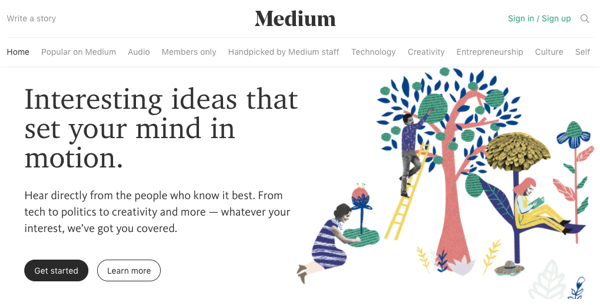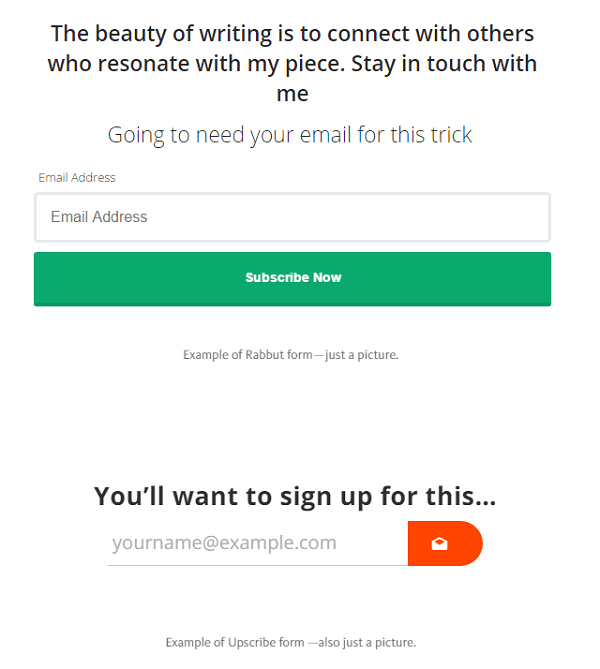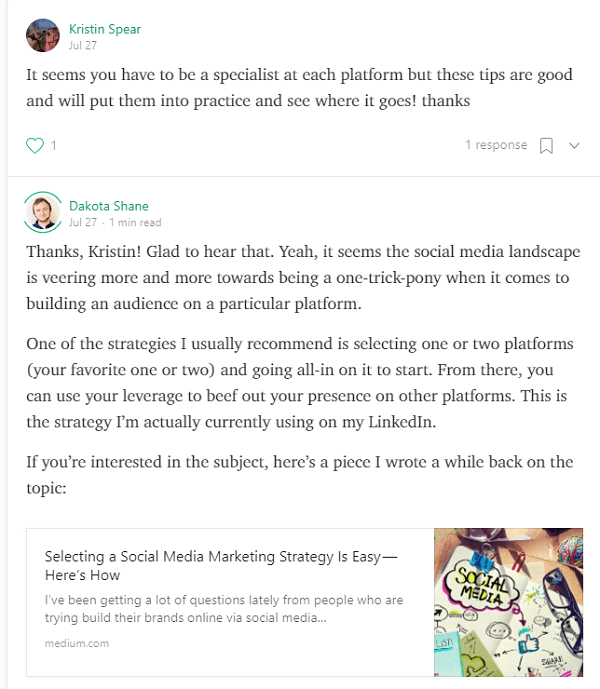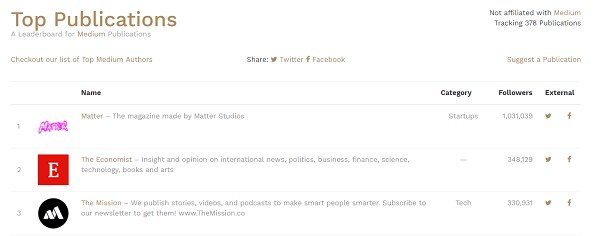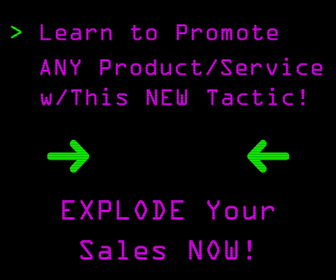Founded in late 2012, this online publishing platform has gained a lot of traction since its introduction.
A lot of people use this platform as either their primary blog — you can set up a custom domain name with it — or they syndicate some of their content on the site.
Ever heard of Medium?
The big advantage to Medium is that it has its own pre-existing built-in audience.
It's pretty easy for people to find and read your content, so you can end up in front of a whole new audience that might not have known about you otherwise.
It's a great place to syndicate some of your content.
(There's a chance this could mess with your SEO, so be sure to account for that before you repost an entire article.)
In a recent post and podcast, Social Media Examiner explains why you should give Medium a try.
Why Write on Medium?
There are four reasons to write on Medium. First, Medium provides a ready-made audience that most writers, creators, or marketers don’t have and that would take years to build.
[image source: Social Media Examiner]
Medium’s ready-made audience can help jumpstart your positioning.
Second, and most importantly, Medium presents an opportunity right now because it’s at that sweet spot between an emerging platform (which could be a risk) and an established platform (which could be saturated).
Since it’s in this position, Medium can open doors for a creator, writer, or marketer to brand themselves as an authority on a specific subject.
Although Medium has kept recent metrics to themselves, as of late 2016 there were 60 million monthly users on Medium. From 2015 to 2016, the number of posts has increased by 295%.
Third, Medium can help you build an email list.
Simply include a call to action in your article that either links to your squeeze page or add an email capture tool such as Rabbut or Upscribe. These free tools allow you to gather emails on Medium itself.
With Medium’s ability to embed files, you can simply embed your email capture tool at the bottom of your articles, making the email-capture process pretty seamless.
[image source: Social Media Examiner]
Gather email addresses on Medium using tools such as Rabbut or Upscribe.
This last reason, which is close to Dakota’s heart, is Medium is a low touch point channel.
It’s not like Twitter, the crying child of social media that needs your attention 24/7. Medium is the good kid who does their chores without being asked. If you’re creating content already, it doesn’t take that much more time to be active on Medium.
Publish articles, respond to comments, and read cool stuff.
Medium co-founder Ev Williams also developed Twitter and Blogger, Dakota adds.
If you have an existing following on Twitter, when you create a Medium account, you import your Twitter contacts who are on Medium. So if 10,000 of your 20,000 Twitter followers are on Medium, you’ll automatically get those 10,000 followers.
Listen to the show to hear Dakota compare Medium to WordPress.
Publications on Medium
If Medium were a newsstand, the publications would be the different magazines, newspapers, and pamphlets available.
Publications cover a range of topics, can publish independently, and can monetize independently of Medium.
After your writing appears via a Medium publication, you have an option to submit any of your stories directly to them.
You can also publish your posts independently. When you go that route, editors may ask to add one of your posts to their publication. You can write for as many Medium publications as you’d like.
However, a story can live on only one publication.
So if you write a story for one publication and then want to publish it on another, you need to take down the first story before you can resubmit it elsewhere.
You have a few options to discover publications. When you sign up for Medium, it gives you suggestions.
A third-party tool called TopPub.xyz ranks publications based on the number of followers and gives you a link to each publication.
[image source: Social Media Examiner]
Top Publications is an excellent discovery tool for Medium publications.
Tags and search are also useful tools for finding publications. Dakota says writers add the tags when they publish a story. (Publishers can add tags too, but typically don’t do so.)
Then, when people type a term in Medium’s search box, they see a section of tags that match the search term and can then see related tags.
For instance, search for “business” in the search bar on Medium and you’ll see a list of tags with the word “business” in the results. Click a tag and you’ll then see articles with that tag, as well as related tags such as “social media” and “marketing.”
You can tailor your feed based on a tag you like. Similarly, you can search for and follow people and publications.
Anyone can create their own publication, but Dakota recommends doing this only if you have someone who has the time to edit it. Editing a publication takes a ton of time, whereas writing articles as a contributor to a publication is less of a time commitment.
I ask how readers are notified when a publication has new content. Dakota says it depends on how the editor of a publication handles outreach. For instance, someone who subscribes to The Mission will receive a mobile notification when new content is published.
Many publications have a newsletter that helps followers stay up to date.
Medium also has features that highlight content for potentially interested readers. Medium sends out email notifications on top stories each day.
On your desktop feed, new content appears in a section for publications you follow.
You can check out the full podcast, plus the rest of the accompanying write-up, over at Social Media Examiner.
CHALLENGE Yourself to Profit!
Free Download: Build Your Profit-Generating Online Business With This Free Blueprint
Sign Up, follow the easy steps and You'll get the tactics, strategies & techniques needed to create your online profit stream. It's free!

